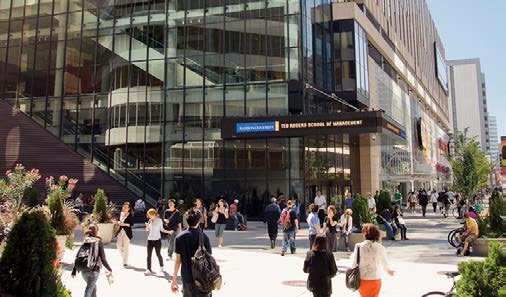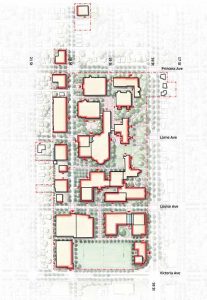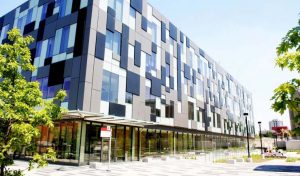Frontages & Entrances

The design of buildings is extremely important in a campus context. Buildings play a critical role in creating a welcoming, accessible, and safe environment by providing a face and eyes on the public realm. Essentially, there should be no back condition to a building, especially where there are few service laneways. This means that the service side of buildings must also be aesthetically pleasing and pedestrian friendly, with windows, door access points, and landscaping. Even laneways have to function as contributing components of the public realm and pedestrian circulation.

Schedule 03 Mixed-Use Campus Approach. Building frontages are marked in red, entrances are marked with triangles.
Buildings along the edge should reflect the pulse of the Campus. Building frontages should be designed to be animated, transparent, and engaging to the community. These buildings should reflect the Campus’ pedagogical function and internal activity such as learning labs, social gathering spaces, gallery and recreational space. They should also be the locations for community gathering spaces that are visibly and physically accessible from the Campus’ periphery.
Policies:
- All campus buildings should have articulated frontages on all sides in order to address, and provide an attractive face to, the surrounding public realm and open spaces.
- Building frontages must create a welcoming and attractive street environment for pedestrians. All buildings must have welcoming façades, with front door access connecting to the sidewalks, pathways, and streets.
- Buildings must engage all aspects of the public realm that surrounds them, whether it be a pedestrian corridor, an open space, a service route, or a street.
-

Precedent: Transparency at grade, canopies, and multiple access points create a comfortable and safe environment.
Building must have multiple points of access, and a high level of transparency to all open spaces, streets, and pedestrian passageways to create a comfortable, and safe environment.
- Buildings should provide lighting, and weather mitigation, such as canopies to create safe and comfortable open spaces.
- Large blank walls or uninterrupted building masses should be avoided.
- Building must have “unlocked” access to all open spaces to encourage use, passage, and enjoyment throughout the year, and to provide a greater level of permeability through the campus.
- Service entrances and areas should not be located in the front of buildings and should be consolidated where possible, along a shared service corridor. The design of service entrances and loading areas must be integrated as part of the public realm design.
